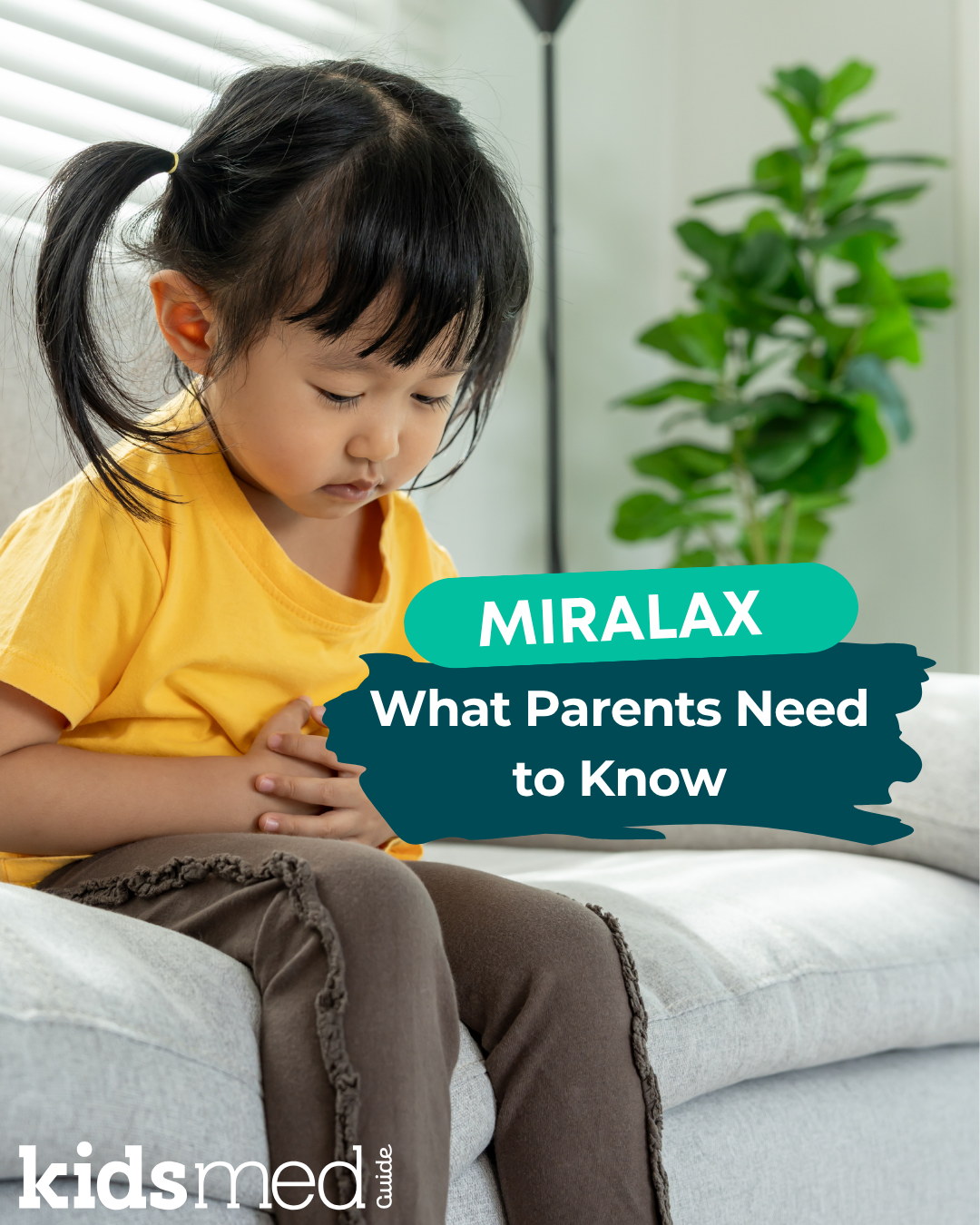Miralax in Children: Is It Safe?

Constipation in children can happen for many reasons. Sometimes it’s related to diet. Often, it’s linked to behavior or psychological factors. In my house, we’ve dealt with it occasionally during potty training, because my toddler outright refuses to poop on the potty. Read our essay, The Diaper Chronicles, Part 1, to laugh (or cry) about potty training struggles.
Whatever the cause, constipation is a common issue that many kids and parents face. There are many non-medication ways to treat constipation in children, and ideally, you can identify the root cause or contributing factors. But sometimes, you need that extra push to get things—er—moving again!
Miralax is one of the most commonly recommended and prescribed medications for treating constipation in children. When used as directed by your pediatrician or pharmacist, it is safe!
What Is Miralax?
Miralax (polyethylene glycol 3350) is an over-the-counter osmotic laxative. It works by drawing water into the colon, softening the stool and making it easier to pass, without causing the cramps or urgency that stimulant laxatives may produce.
Is It Safe for Kids?
The FDA hasn’t formally approved Miralax for children under 17. However, it’s commonly recommended off-label by pediatricians. Trust me on this—I've worked in a pediatric hospital for many years, and we used so much Miralax that we had to pre-pack it in typical pediatric doses! It’s a safe option for treating constipation—which is common in hospitalized children—and it was very popular.
However, don’t just take my word for it 😄. Studies and clinical guidelines from the American Academy of Pediatrics (AAP) and the North American Society for Pediatric Gastroenterology, Hepatology, and Nutrition (NASPGHAN) endorse its short- and long-term use in children with chronic constipation.
When diet, behavior, and lifestyle changes aren’t working and a laxative is needed, Miralax is often your best bet!
When Is It Used?
Miralax is typically used for:
- Chronic constipation
- Stool withholding behaviors
- Clean-outs for severe cases or for medical procedures (higher dose, short-term)
- Maintenance therapy over weeks or months, under medical guidance
How to Give Miralax to Kids
- Mix with 4-8 oz of any clear or cold liquid (water, juice, milk)
- Start with a pediatric-recommended dose—commonly 0.4 grams per kilogram of body weight per day, up to one adult dose, which is a capful (17g)
- This may be tricky to figure out, as most parents don’t have a scale to measure exactly 0.4 grams per kilogram.
- Work with your doctor or pharmacist to calculate your child’s weight-based dose, then use that to find the nearest measurable standard dose (caps usually have markings inside for standard pediatric doses, or you may have to estimate a portion of a 17-gram packet)
- Effects usually occur within 24–72 hours
- Adjust the dose based on stool consistency and frequency (with medical guidance)
Tips for Success
- Use consistently at the same time each day
- Combine with a high-fiber diet and hydration
- Keep a bathroom routine (e.g., sitting on the toilet after meals)
- Don't stop abruptly if your child has been withholding; they may need weeks to months of maintenance and a slow wean plan to get off the medication. This should be done in conjunction with lifestyle modifications and behavioral interventions.
You'll have the most success if you also understand constipation and slowly work on lifestyle changes. I like this guide from the American Academy of Pediatrics on Constipation in Children, because it explains the different types of constipation and non-drug ways to treat it!
Concerns About Long-Term Use
Some parents are concerned about long-term safety due to news reports about the potential for contaminants causing neurotoxicity or autism spectrum disorder. However, studies have not proven harmful neurological effects. Ongoing research and reviews from the AAP and NASPGHAN continue to support the safety of Miralax when used as directed.
Always consult your pediatrician before using it for an extended period of time. If your child struggles with chronic constipation, work with your pediatrician on a multi-faceted treatment plan. There are other treatment options if long-term use of Miralax is concerning to you.
Rarely is constipation unavoidable due to medical conditions or other medications a child must take. However, in healthy children, constipation can be effectively managed through dietary adjustments, increased fluid intake, regular physical activity, and behavioral modifications.
Miralax is a good first choice because it is a gentle laxative; however, as always, we should try to limit medication in children to the lowest dose for the shortest reasonable time. As I always say, less medication is better for kids!
When to Call the Doctor
- No improvement after a few days
- Blood in stool
- Vomiting, severe pain, or distension
- Suspected impaction or dehydration
- Persistent irritability or crying in infants and young children
Final Thoughts
Miralax can be a gentle and effective way to manage constipation in children. When used correctly—and with your pediatrician’s guidance—it helps many kids (and their parents!) find much-needed relief.
For optimal care, constipation in children should also be treated with non-drug approaches, such as increasing water and fiber intake, staying active, and establishing good bathroom routines.
The following references were used to compile this information:
Constipation in Children. (2007, March 1). HealthyChildren.Org. https://www.healthychildren.org/English/health-issues/conditions/abdominal/Pages/Constipation.aspx
DailyMed—MIRALAX- polyethylene glycol 3350 powder, for solution. (n.d.). Retrieved June 23, 2025, from https://www.dailymed.nlm.nih.gov/dailymed/drugInfo.cfm?setid=d69ce3d4-7ca4-4fe3-b49e-6655e48d6963
Tabbers, M. M., DiLorenzo, C., Berger, M. Y., Faure, C., Langendam, M. W., Nurko, S., Staiano, A., Vandenplas, Y., & Benninga, M. A. (2014). Evaluation and Treatment of Functional Constipation in Infants and Children: Evidence‐Based Recommendations From ESPGHAN and NASPGHAN. Journal of Pediatric Gastroenterology and Nutrition, 58(2), 258–274. https://doi.org/10.1097/MPG.0000000000000266
